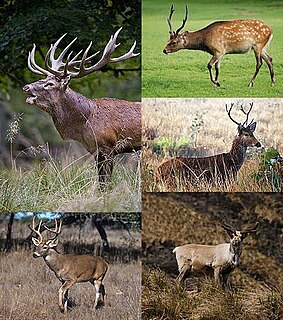
Deer are the hoofed ruminant mammals forming the family Cervidae. The two main groups of deer are the Cervinae, including the muntjac, the elk (wapiti), the fallow deer, and the chital; and the Capreolinae, including the reindeer (caribou), the roe deer, and the moose. Female reindeer, and male deer of all species except the Chinese water deer, grow and shed new antlers each year. In this they differ from permanently horned antelope, which are part of a different family (Bovidae) within the same order of even-toed ungulates (Artiodactyla).

The fallow deer is a ruminant mammal belonging to the family Cervidae. This common species is native to Europe, but has been introduced to Antigua & Barbuda, Argentina, South Africa, Fernando Pó, São Tomé, Madagascar, Mauritius, Mayotte, Réunion, Seychelles, Comoro Islands, Morocco, Algeria, Tunisia, Cyprus, Israel, Cape Verde, Lebanon, Australia, New Zealand, Canada, the United States, the Falkland Islands, and Peru. Some taxonomers include the rarer Persian fallow deer as a subspecies, while others treat it as an entirely different species.

The white-tailed deer, also known as the whitetail or Virginia deer, is a medium-sized deer native to North America, Central America, Ecuador, and South America as far south as Peru and Bolivia. It has also been introduced to New Zealand, Cuba, Jamaica, Hispaniola, the Bahamas, the Lesser Antilles, and some countries in Europe, such as the Czech Republic, Finland, Romania, Serbia, Germany, and France. In the Americas, it is the most widely distributed wild ungulate.
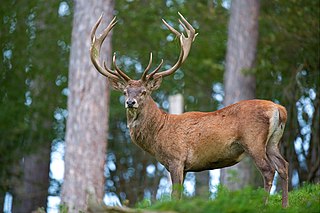
The red deer is one of the largest deer species. The red deer inhabits most of Europe, the Caucasus Mountains region, Asia Minor, Iran, parts of western Asia, and central Asia. It also inhabits the Atlas Mountains region between Morocco and Tunisia in northwestern Africa, being the only species of deer to inhabit Africa. Red deer have been introduced to other areas, including Australia, New Zealand, United States, Canada, Peru, Uruguay, Chile and Argentina. In many parts of the world, the meat (venison) from red deer is used as a food source.

Deer Island is one of the Fundy Islands in the Bay of Fundy, Canada. It is at the entrance to Passamaquoddy Bay.

The water deer is a small deer superficially more similar to a musk deer than a true deer. Native to China and Korea, there are two subspecies: the Chinese water deer and the Korean water deer. Despite its lack of antlers and certain other anatomical anomalies—including a pair of prominent tusks, it is classified as a cervid. Its unique anatomical characteristics have caused it to be classified in its own genus (Hydropotes) as well as its own subfamily (Hydropotinae). However, studies of mitochondrial control region and cytochrome b DNA sequences placed it near Capreolus within an Old World section of the subfamily Capreolinae. Its prominent tusks, similar to those of musk deer, have led to both being colloquially named vampire deer in English-speaking areas to which they have been imported. The species is listed as Vulnerable by the IUCN.

Pampas deer is a species of Deer that live in the grasslands of South America at low elevations. They are known as venado or gama in Spanish and as veado-campeiro in Portuguese. Their habitat includes water and hills, often with winter drought, and grass that is high enough to cover a standing deer. Many of them live on the Pantanal wetlands, where there are ongoing conservation efforts, and other areas of annual flooding cycles. Human activity has changed much of the original landscape. They are known to live up to 12 years in the wild, longer if captive, but are threatened due to over-hunting and habitat loss. Many people are concerned over this loss, because a healthy deer population means a healthy grassland, and a healthy grassland is home to many species, some also threatened. Many North American birds migrate south to these areas, and if the Pampas deer habitat is lost, they are afraid these bird species will also decline. There are approximately 80,000 Pampas deer total, with the majority of them living in Brazil.

The Kaibab Plateau is located in northern Arizona in the United States. The plateau, part of the larger Colorado Plateau, is bordered on the south by the Grand Canyon and reaches an elevation of 9200 feet above sea level. The plateau is divided between Kaibab National Forest and the "North Rim" portion of Grand Canyon National Park. Tributary canyons of the Colorado River form the plateau's eastern and western boundaries, and tiers of uplifted cliffs define the northern edges of the land form. Winter snowfall is often heavy, and this creates opportunities for backcountry Nordic skiing and snow camping.
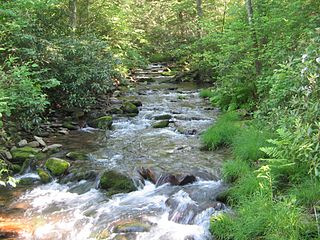
White Deer Hole Creek is a 20.5-mile (33.0 km) tributary of the West Branch Susquehanna River in Clinton, Lycoming and Union counties in the U.S. state of Pennsylvania. A part of the Chesapeake Bay drainage basin, the White Deer Hole Creek watershed drains parts of ten townships. The creek flows east in a valley of the Ridge-and-valley Appalachians, through sandstone, limestone, and shale from the Ordovician, Silurian, and Devonian periods.

The Siberian musk deer is a musk deer found in the mountain forests of Northeast Asia. It is most common in the taiga of southern Siberia, but is also found in parts of Mongolia, Inner Mongolia, Manchuria and the Korean peninsula.

Deer Creek is a 60-mile-long (97 km) southwestward-flowing stream in Northern California that flows through Tehama County, California. It is an eastside tributary of the Sacramento River. As one of only three remaining Sacramento River tributaries supporting native runs of the genetically distinct Central Valley spring-run Chinook salmon, it is a stronghold for this state and federally endangered fish as well as other salmonids.

White Deer Creek is a tributary of the West Branch Susquehanna River in Centre County and Union County, in Pennsylvania, in the United States. It is approximately 28 miles (45 km) long and flows through Miles Township in Centre County and Hartley Township, Lewis Township, West Buffalo Township, and White Deer Township in Union County. The watershed of the creek has an area of 45.1 square miles (117 km2). Parts of the creek are designated as impaired. The creek's discharge near White Deer can be as low as 3 cubic feet per second (0.085 m3/s) or as high as 169 cubic feet per second (4.8 m3/s).

Deer hunting is hunting for deer for meat or sport, an activity which dates back tens of thousands of years. Venison, the name for deer meat, is a nutritious and natural food source of animal protein that can be obtained through deer hunting. There are many different types of deer around the world that are hunted for their meat.

Linn Run State Park is a Pennsylvania state park on 612 acres (248 ha) in Cook and Ligonier Townships, Westmoreland County, Pennsylvania in the United States. The park borders Forbes State Forest. Two smaller streams, Grove Run and Rock Run, join in Linn Run State Park to form Linn Run which has a waterfall, Adams Falls, which can be seen at the park. This state park is just off Pennsylvania Route 381 near the small town of Rector.
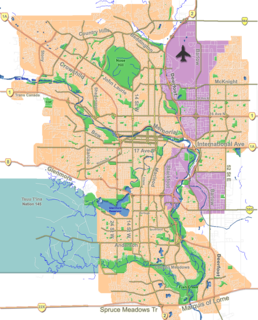
Deer Ridge is a residential neighbourhood in the southeast quadrant of Calgary, Alberta. It is located in the Bow River valley, and is bounded to the north by Canyon Meadows Drive, to the east by Deercliff Road and the Bow River, to the south by Deerfield Circle and the community of Deer Run and to the west by Bow Bottom Trail. Fish Creek Provincial Park is located immediately east.

Deer Run is a residential neighbourhood in the southeast quadrant of Calgary, Alberta. It is located in a bend of the Bow River, and is surrounded to the east and south by the Fish Creek Provincial Park. It is bounded to the north by North Deersaxon Circle and the community of Deer Ridge and to the west by Bow Bottom Trail.

Earl Dreeshen is a Canadian politician, currently serving as a Member of Parliament with the Conservative Party.
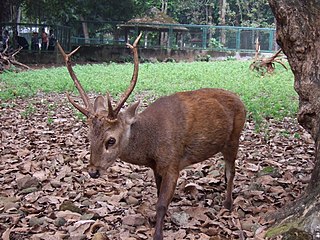
The Bawean deer, also known as Kuhl's hog deer or Bawean hog deer, is a highly threatened species of deer found only in the island of Bawean in Indonesia.

The Deer Park, Hisar, is near the town of Hisar, in the Hisar district of Haryana State, India. It has an area of 19 hectares including a 6-acre plot for producing fodder for the deer.
The Deer Park–West Werribee railway line is on the western fringes of the metropolitan area of Melbourne, Victoria, and is part of the Regional Rail Link. It was constructed between June 2012 and October 2014 and opened on 21 June 2015.




















